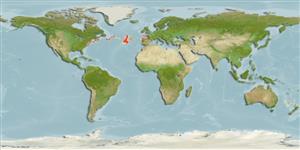Elasmobranquios (tiburones y rayas) (sharks and rays) >
Rajiformes (Skates and rays) >
Arhynchobatidae (Softnose skates)
Etymology: Bathyraja: Greek, bathys = deep + Latin, raja, -ae = a ray (Raja sp) (Ref. 45335).
Environment: milieu / climate zone / depth range / distribution range
Ecología
marino batidemersal; rango de profundidad 803 - 2500 m (Ref. 26346). Deep-water; 48°N - 42°S
North Atlantic and South Pacific (Cook Strait, New Zealand), but probably cosmopolitan.
Tamaño / Peso / Age
Maturity: Lm ? range ? - ? cm
Max length : 175 cm TL macho / no sexado; (Ref. 3167)
Short description
Morfología | Morfometría
Grey in color; diamond-shaped and without large thorns on body or tail (Ref. 26346).
Found in deepwater on lower parts of continental slopes, on submarine rises and on deep-sea plains adjacent to both (Ref. 3167). Feeds mainly on fishes, with a small amount of shrimps (Ref. 3167). Oviparous (Ref. 50449). Eggs have horn-like projections on the shell (Ref. 205). Minimum depth reported taken from Ref. 3167.
Life cycle and mating behavior
Madurez | Reproducción | Puesta | Huevos | Fecundidad | Larva
Oviparous (Ref. 3167). Paired eggs are laid. Embryos feed solely on yolk (Ref. 50449). Eggs have horn-like projections on the shell (Ref. 205).
McEachran, J.D. and K.A. Dunn, 1998. Phylogenetic analysis of skates, a morphologically conservative clade of elasmobranchs (Chondrichthyes: Rajidae). Copeia 1998(2):271-290. (Ref. 27314)
IUCN Red List Status (Ref. 130435)
Threat to humans
Harmless
Human uses
Más información
Age/SizeCrecimientoLength-weightLength-lengthLength-frequenciesMorfometríaMorfologíaLarvaDinámica larvariaReclutamientoAbundanciaBRUVS
ReferenciasAcuiculturaPerfil de acuiculturaRazasGenéticaElectrophoresesheritabilidadEnfermedadesProcesamientoNutrientsMass conversion
Herramientas
Special reports
Download XML
Fuentes de Internet
Estimates based on models
Preferred temperature (Ref.
123201): 3.6 - 6.1, mean 4.3 °C (based on 43 cells).
Phylogenetic diversity index (Ref.
82804): PD
50 = 0.5000 [Uniqueness, from 0.5 = low to 2.0 = high].
Bayesian length-weight: a=0.00513 (0.00253 - 0.01042), b=3.12 (2.95 - 3.29), in cm total length, based on LWR estimates for this Genus-body shape (Ref.
93245).
Nivel trófico (Ref.
69278): 4.0 ±0.69 se; based on food items.
Resiliencia (Ref.
120179): Bajo, población duplicada en un tiempo mínimo de 4.5-14 años (Fec assumed to be <100).
Fishing Vulnerability (Ref.
59153): Very high vulnerability (90 of 100).
Nutrients (Ref.
124155): Calcium = 2.37 [0.33, 47.38] mg/100g; Iron = 0.234 [0.023, 3.143] mg/100g; Protein = 14.3 [12.5, 16.3] %; Omega3 = 0.382 [0.143, 1.021] g/100g; Selenium = 23.9 [4.2, 108.6] μg/100g; VitaminA = 3.7 [0.2, 51.6] μg/100g; Zinc = 0.235 [0.015, 2.834] mg/100g (wet weight);
